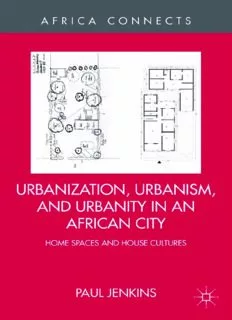
Urbanization, Urbanism, and Urbanity in an African City: Home Spaces and House Cultures PDF
Preview Urbanization, Urbanism, and Urbanity in an African City: Home Spaces and House Cultures
Africa Connects Series Editors G arth Myers ( University of Kansas) and Martin J. Murray (University of Michigan), This scholarly series stands at the intersection of globalization and develop- ment studies, examining the social, political, and economic effects of these processes on the African continent. For advocates and critics alike, globaliza- tion and development are inescapable “facts of life” that define the param- eters of social action not just in Africa but throughout the world. Yet while academic debates and policy discussions careen between praise and criticism, too little attention is given to how these processes actually operate in African settings. Rather than simply reacting to the mainstream scholarly literature, books in this series seek to creatively engage with contemporary debates as a way of developing new perspectives that establish and analyze the linkages between globalization and development. Published by Palgrave Macmillan: Encountering the Nigerian State Edited by Wale Adebanwi and Ebenezer Obadare Zambia, Mining, and Neoliberalism: Boom and Bust on the Globalized Copperbelt Edited by Alastair Fraser and Miles Larmer Fixing the African State: Recognition, Politics, and Community-Based Development in Tanzania Brian J. Dill Migrant Women of Johannesburg: Everyday Life in an In-Between City Caroline Wanjiku Kihato Urbanization, Urbanism, and Urbanity in an African City: Home Spaces and House Cultures Paul Jenkins Also by Paul Jenkins Urban Development and Civil Society: The Role of Communities in Sustainable Cities (2001), edited with Michael Carley and Harry Smith. Place Identity, Participation and Planning (2004), edited with Cliff Hague. Edinburgh: the Making of a Capital City (2005), edited with Brian Edwards. Housing and Planning in the Rapidly Urbanising World (2006), authored with Harry Smith and Ya Ping Wang. Architecture, Participation and Society (2009), edited with Leslie Forsyth. Order & Disorder in Urban Space and Form (forthcoming, 2014) authored with Harry Smith. Urbanization, Urbanism, and Urbanity in an African City Home Spaces and House Cultures Paul Jenkins URBANIZATION, URBANISM, AND URBANITY IN AN AFRICAN CITY Copyright © Paul Jenkins, 2013. Softcover reprint of the hardcover 1st edition 2013 978-1-137-38016-6 All rights reserved. First published in 2013 by PALGRAVE MACMILLAN® in the United States—a division of St. Martin’s Press LLC, 175 Fifth Avenue, New York, NY 10010. Where this book is distributed in the UK, Europe and the rest of the world, this is by Palgrave Macmillan, a division of Macmillan Publishers Limited, registered in England, company number 785998, of Houndmills, Basingstoke, Hampshire RG21 6XS. Palgrave Macmillan is the global academic imprint of the above companies and has companies and representatives throughout the world. Palgrave® and Macmillan® are registered trademarks in the United States, the United Kingdom, Europe and other countries. ISBN 978-1-349- 47914-6 ISBN 978-1-137-38017-3 (eBook) DOI 10.1057/9781137380173 Library of Congress Cataloging-in-Publication Data is available from the Library of Congress. A catalogue record of the book is available from the British Library. Design by Newgen Knowledge Works (P) Ltd., Chennai, India. First edition: December 2013 10 9 8 7 6 5 4 3 2 1 This book is dedicated to my extended family in the peri-urban areas of Maputo, especially Jacinta, Rachel, and Lillian—as well as Chico and his family—but most of all to the memory of my mother-in-law, who passed away not long before the most recent research was completed, after almost a century of urban living in the city’s ever-expanding area: Wisa Ha Hombe Vovo Muchapo This page intentionally left blank Contents List of Figures i x List of Tables xi Foreword xiii Acknowledgments x vii Part I Introductory Material 1 1 The Aims and Objectives of the Book 3 2 The Intellectual Approach of the Book 25 Part II Contextual Material 4 3 3 Contextualization at Macro-Level 4 7 4 Contextualization at Meso-Level 79 5 Contextualization at Micro-Level 1 05 Part III Empirical Material 1 37 6 Life Stories 139 7 Integrated Findings 1 77 8 Key Issues Arising 1 99 Part IV Concluding Material 221 9 Queries and a Proposal 2 23 Notes 2 45 Bibliography 2 63 Index 269 This page intentionally left blank Figures 3.1 Map of Mozambique showing main urban areas and provincial boundaries 6 4 4.1 P lan of Lourenç o Marques in 1876 showing ramparts, fort, customs house, governor’s house, public well, and road to Lydenburg 81 4.2 Plan of Lourenç o Marques in 1903 showing the F oral area, and its incorporation of the Polana headland township 83 4.3 P lan of Lourenç o Marques in 1929 showing the slow occupation of the planned area and the initial planned expansion to the northeast 85 4.4 L and cadaster plan of Lourenç o Marques in 1940 showing the unplanned expansion to the northwest and also the planned area for a ssimilados 86 4.5 L ourenç o Marques general urban expansion plan 1952 “Aguiar Plan,” showing planned expansion to northeast, avoiding existing unplanned “reserves” to the northwest 8 8 4.6 Lourenç o Marques master plan 1972, detailing planned land uses for the city-region, and a proposed bridge across the estuary to the west from Matola 9 1 4.7 L and-use mapping based on aerial photography for Greater Maputo area 1969–79 94 4.8 T wo planned alternatives for the Greater Maputo area in the 1985 Structure Plan 95 4.9 Land-use mapping based on aerial photography for Greater Maputo area 1989 and the then contemporary projection of urban growth if uncontrolled 98 4.10 World Bank–funded Metropolitan Maputo Structure Plan 1999 9 9 4.11 M aputo city Structure Plan 2010: Main proposals 1 01
